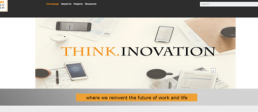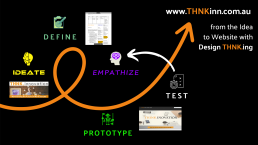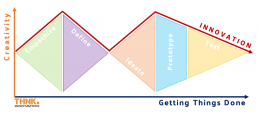What Job Do You Need Your Website To Do?
What Job Do You Need Your Website To Do?
December 21, 2020 by David Hauser
Hello fellow innovators and different THNKers. We are rapidly approaching the 6-month anniversary of our THNK.innovation website.
As the design thinkers that we are, we never did look at the website to be something that is done right once and then will be left on its own. But we were looking at it as a growing product that is going to evolve with our increasing understanding of customer needs.
An experience that we would hardly be able to gather without putting this unfinished first prototype out there to learn from. (Actually, the website that we realised in May wasn’t exactly the first THNK.innovation website…but we won’t talk about this ever again)
Hello fellow innovators and different THNKers. Welcome to my second blog about how applied design thinking is evolving the THNK.innovation website.
In my previous blog, we ended with the revelation that the three quotes that I received to build my website were spread out over a vast price range. In fact, the lowest offer was more than 10 times less expensive than the dearest quote that I did receive.
Something couldn’t be right. Right?
I figured that the amount of work that the different vendors were thinking is required to build the website must be very different. The most expensive offer must have accommodated for at least five times the hours to build the website compared to the cheaper one.
How could that be? Either one of them was at least 5 times more efficient than the other or both of them had a vastly different understanding of my requirements.
Were we all on the same page with respect to my expectations of the website? Did we all understand what job I needed the website to do for me?
Job to be done
The “job to be done” framework was created by Harvard professor Clay Christensen.
Dr Christensen is explaining the “job to be done” best with an example based on a project that he and his team conducted for one of the large fast-food chains.
After several tries in boosting their sales of milkshakes, conducting consumer testing and surveys, the client approached Dr Christensen to have a look from another angle onto their challenge. They’ve approached the challenge in two steps:
First, one of his team members sat down in one of the restaurants for one day, observing the customers and their buying behaviour. And what they’ve discovered was quite surprising to them. They’ve learned that the majority of the people were coming to the restaurant alone, were buying just a milkshake and nothing else and had theirs for take-away.
Then the next day, the team was going back to the restaurant. But this time they were placing themselves just outside next to the exits. They were engaging the buyers of the milkshakes in a conversation, and they were asking them what job it is that their freshly purchased milkshake is doing for them.

What they’ve learned was that most of the buyers had in common that they bought their milkshake in the morning on their drive to work.
- They were after something that they can safely consume with one hand while driving.
- Something that is keeping them busy for the full 30 minutes of their commute.
- And something that is filling enough to get them through the morning without the desire for another snack.
These are the three jobs that the milkshake buyers were looking to get done.
What they needed was a more satisfying and longer-lasting milkshake…a thick shake!
Matching the applicant to the job
Coming back to my website building challenge and the quotes that I did have on my desk. A spread of the price range by a full magnitude made these offers hardly comparable. But what if I could define the jobs that I needed the website to do for me first and then see which of the proposals is ticking most of the boxes?
What are these jobs that the THNK.innovation website does have to do for me?
- Creating and growing the business: I’m not investing several thousands of dollars into a website for the sake of having a website. The purpose of the website is to support the growth of THNK.innovation by helping potential clients to find me on the internet. And then to convince them that it is worth their time to engage with me and explore if they want to allow me to prove the value of my services to them.
- Grow and change with me and THNK.innovation: It is in the early stages of a new business when we learn the fastest. Any business model is a collection of assumptions in the first place. Some of these assumptions will prove to be right and working, others not so much. Whenever the second happens, and I do have to adjust the business model, the website and its communication must follow suit.
- Make me more independent: Whoever I’m going into business with must put my success 1st and is empowering my independence. In the case of the website, this means that the design and UI must make it easy for me to modify content as well as most of the user experience myself. If at all, then I only want to have to go back to my developer to add functionality but not for repetitive updates.
Equipped with this clear understanding, I went back to the quotes and reviewed how each of them did promise to satisfy each of the three jobs that I need to be done.
Vendor A only gave me the confidence to do job No 2. And this was mainly due to the low-price tag which would have allowed me to pay for quite some updates before reaching the prices that the other two quoted.
Vendor B, and established agency with defined products and services, convinced me that their product would do a little bit of everything but mainly on their terms. Yet with them, I felt too much like a passenger on my own journey instead of steering my destiny.
I opted for vendor C. It wasn’t because I did trust them to do all the required jobs in high quality straight away. But I had high confidence that they would have the patience to grow with me and the business. And this would then allow us to gradually progress and improve in getting the other two jobs done, too.
Additionally, they were operating out of the same office as I do. Therefore, communicating directly with the developers was much more comfortable than with the other two vendors who had at least parts of the work offshored.
Finally, we were ready to get started building a website!
And if you want to know what we’ve learned during the build, which compromises I had to accept and more…then stay tuned for the next part of this blog.
If you missed out on the first part then just click here
Do you want to know how I resolved this wicked problem applying the design thinking methodology and the “Jobs to be done” framework?
Then subscribe to our newsletter now and don’t miss any of the other parts of this blog series about applied design thinking and continuous improvement.
Explore our full portfolio on www.THNKinn.com.au
Or book your personal exploration call with me now!
Like what you read? Share it
Applied Design Thinking In Website Development
Applied Design Thinking In Website Development
November 2, 2020 by David Hauser
Hello fellow innovators and different THNKers. We are rapidly approaching the 6-month anniversary of our THNK.innovation website.
As the design thinkers that we are, we never did look at the website to be something that is done right once and then will be left on its own. But we were looking at it as a growing product that is going to evolve with our increasing understanding of customer needs.
An experience that we would hardly be able to gather without putting this unfinished first prototype out there to learn from. (Actually, the website that we realised in May wasn’t exactly the first THNK.innovation website…but we won’t talk about this ever again)
When I started THNK.innovation journey, I did have an idea about the business that I wanted to build and the services that I wanted to offer. What I didn’t have was much of an idea about the market that I’m going to enter into or the pain points of my desired customers. Or maybe even who exactly these chosen customers are going to be.
What I did know was that my experience as a design engineer in solving wicked, multilayered problems is valuable. As well as that the powerful strategies and tools that I’ve learned to use solving these problems can be applied to other areas but the general engineering disciplines, too.

In the early stages of any new adventure that one is embarking on, there is a lot of learning happening. And this wasn’t much different for me either. I’ve learned a lot.
-
- I did gather a better understanding of the things that I did already know and how they can fit into the bigger picture.
- I did learn things that I was aware of that I didn’t know them
- I did learn things that I didn’t know of not knowing them
With that, many of not knowing it would have been easy for me to give myself permission to be scared at that time. Use all the things that I still had to learn as an excuse to procrastinate, not building a website and not going life.
But I did it anyway!
This is going to be the start of a series of blog posts, in which I will share with you the evolution not just of my website but also of THNK.innovation, as well as the story of my personal development as a first-time founder. I’m also going to explain how my experience from being an engineer and designer helped me to make better decisions throughout the process.
Ready? Great, let’s get started!
In January 2020, I made my mind up that I will finally dedicate all of my energy into building my dream of THNK.innovation. An agency to coach and facilitate practical innovation.
I decided to build my methodology around the design thinking framework that was developed over 60 years ago by engineers and architects and to refine it with some modern tools and strategies that turned out extremely useful throughout my own engineering career.

My targeted clients are start-ups, teams in corporates and organisations as well as individuals that are thriving for making better decisions and creating products, services and systems that are exceeding the expectations of their users.
With such an understanding of the business of THNK.innovation in mind, I felt comfortable to go public with my services via social media activities but also my own website.
With future growth, added functionality and flexibility to change developers in mind I opted straight away to leave the general drag ‘n drop website builders behind and specified that the site to be built in WordPress.
I went shopping for a website development in WordPress with
-
- A frontpage that summarises the business and its services
- An “About Us” page
- Three service pages to detail my offerings
- A download section fro freebies
- A blog
- Terms&Conditions and Privacy Policy pages
Ten pages overall. Straight forward, right?
Yeah, that’s what I thought, too. But I could not have been further off. In the past, I’ve made some less pleasant experiences using freelancing websites for more complex tasks like this one.
That together with the many connections in the start-up community that I’ve accumulated over the years, I decided to stick to my established network and only ask people and agencies that I did know personally based on previous collaborations or referrals by friends.
So I went out and asked them for their initial quotes for my website development.
What would you guess was the range of quotes that I did get for the site with the above requirements? How much more expensive was the dearest one compared to the lowest offer?
-
- 2-times?
- 3-times?
- 5-times?
The most expensive one was actually was twelve times as expensive as the most affordable one.
Even taking into the price difference of onshoring and offshoring into account, something could not have been right. Someone calculated at least 5-times the hours for the same job. Or at least for what I thought would be the same job.
I understood that making a decision based on these first quotes was not healthy. I had to go back to each of the vendors, ask questions, refine my requirements and make sure that they understood them and that I understood what it was that they intended to deliver.
I had to make sure that we all understood what “The Job to be done” was!
To be continued
Do you want to know how I resolved this wicked problem applying the design thinking methodology and the “Jobs to be done” framework?
Then subscribe to our newsletter now and don’t miss any of the other parts of this blog series about applied design thinking and continuous improvement.
Explore our full portfolio on www.THNKinn.com.au
Or book your personal exploration call with me now!
Like what you read? Share it
What do your customers really want?
Don't be the man with a hammer!
August 4, 2020 by David Hauser
Do you feel sometimes as if your customers just do not understand your products or services?
Or is it possible that your products and services do not understand your customers instead?
Getting a thorough understanding of your customers’ needs and desires and to deliver on them is essential for a long-lasting win-win relationship.
Listening with empathy when they are sharing their struggles, sorrows, and dreams with you is not just strengthening your relationship but is also giving providing you with heaps of valuable information about how you can create value for them.
A fabulous tool to bring order into that information, to get an even deeper understanding of their troubles and desires and to identify patterns that allow you to create value for as many of them as possible, is an
Empathy Map
An empathy map can be used in different ways. Most commonly it is applied in the design of user interfaces to learn about how the designated users of your software are interacting with its UI.
Therefore, the users will be observed while using the software a prototype of it. The persons conducting the test will watch the user and triggered by their reactions ask them “what do you see” and “what do you feel” and are writing the answers in the corresponding quadrant of the empathy map.
The other two quadrants the testers are filling in with relevant words or phrases the user used to express themself and with what the user is telling them about what they do understand other people’s opinions and experiences are.

A second application of the empathy map is to use it to bring structure into your notes of one on one interviews. Recently we at THNK.innovation did conduct a research project for Silicon Beach Group to get a better understanding for their community members, their pain points as well as their individual goals.
With the consent of the participants, we did video record all the interviews. We then went on by reviewing the recordings, taking notes of the interviewees’ answers, their choice of words and their body language, and transferred our notes in the 4 quadrants of the empathy map of each interviewee.
- What do they say and do– what’s their choice of words and their body language?
- What do they hear – their family, friends, peers, media, experts, and others saying?
- What do they see – when looking at their own and other people’s lives, careers, and businesses?
- What do they think and feel – when they hear, see, say, and do?
Having all the information for each of our interviewees aggregated we move on by transferring “the secret sauce” of what with learned into the two sections at the bottom of the empathy maps. What is it causes them pain and what are their personal as well as career and business goals in life?
Here it is where we are digging deeper than the spoken word and assisted by our records of the interviewee’s body language, we are reading in-between the lines to identify pains and goals that they might not be even consciously aware of.

You’re neither a user interface designer nor are you curating a huge online community?
So, what can empathy mapping do for you ask?
Regardless of what industry you are in, your long-term success depends on understanding what causes your customers’ and clients’ pain and what their conscious, as well as subconscious goals, are.
Empathy mapping is going beyond the information about your customers that you are already maintaining in your CRM system.
It will help you to clarify your understanding of how you can serve them best and how their needs are changing in demanding times like these.
It will allow you to empathize more closely with them by putting yourself into their shoes and create value for them that is beyond what they can envision themselves.
Download our free empathy map templates now
and be ready to start filling them with your customer’s life the very next time you are talking to them.
Get to know them empathetically and put yourself in a position to support them on their journey better than ever before!
Don’t be the man with a hammer, be the person with an empathy map!
Explore our full portfolio on www.THNKinn.com.au
Or get in touch and ask me personally david@THNKinn.com.au
Like what you read? Share it
Getting (Creative) Things Done
Getting (Creative) Things Done with Design Thinking
July 2, 2020 by David Hauser
During my years of working as an industrial design engineer and project manager, I learned that there are two domains in the business world that are often believed to be opposed to and competing with each other. Depending on which side of the fence I placed myself due to the role that I was assigned to, I argued for and against the importance and priority of one against the other.
Can you guess what these two domains are?
I’m talking about Creativity and Execution!
In his book Getting Things Done – The art of stress-free productivity, author David Allen describes the ability to get things done (GTD) as the ability to do what needs to be done or what you chose to get accomplished by minimising distractions. One of his main lessons is that we should get started with his GTD-practice by tidying up. Tidying up everything from our to-do and bucket lists to our desks and any databases that we are working with.
But most importantly, tidying up the database that we are carrying around in our heads by emptying it out into a physical notebook or a piece of suitable software.

The idea behind it is that our brains only have a limited capacity to deal with multiple things at the same time. You can think about it like the RAM storage of your computer or smartphone. The storage in which every set of data is temporarily held ready to access for all the programs, apps, and widgets that are open at any given time. It can only deal with so many requests from active software before its capacity is reached and it will slow your device and applications down, or in a worst-case even causing them to crash.
And the very same principle applies to our brains, too.
The more open tasks we are carrying around in our brains, the more open loops we are thinking of at any given time, the more of its capacity is diverted away from the most important task. The result is that we are getting slowed down in our efforts to accomplish our set goals.
Getting all our ideas out of our head by writing them down in whatever form we chose to, is the equivalent of closing a program or app that we are not using right at the moment. The information or work in progress is not getting lost but stored in a secure location to which we can go back and pick it up again exactly where we left off. But for the moment it frees up our brain capacity to focus on our tasks on hand with minimal risk of internal distraction and confusion.
As a result, we are getting the work done quicker and are most likely delivering it in higher quality, too. And all of it with plenty of time left to spare.
Time to be used for being creative.
Time for developing ideas about how to generate new value.
Time to care for your customers, your business, your loved ones, or yourself.
The Design Thinking methodology can do the very same for you and your operation, too, by providing you with a plan of when to be creative and ideate, and when you have to get things done.

No model of the methodology is visualising this better than the double diamond.
It is the double diamond model of the design thinking process that is visualising it best.
Divided into the 5 steps of Empathise, Define, Ideate, Prototype, Test, it defines clearly where there is space for being creative and when we have to get to it and get it done!
In the Empathise and Ideate stages of the process, you are encouraged to be creative, explore new ideas, and think out of your own boxes.
Whereas in the Define and Prototype/Test stages you are bringing everything back to the point, execute, and getting things done.
Reading the double diamond diagram as a project timeline with the time axis in the horizontal, it becomes quite clear that creativity and execution -or getting things done- are not opposing each other but are working together.
Efficient execution and getting to point with a purpose are freeing up time that can be used for more creative thinking and the generation of more ideas to explore. And more ideas are giving you and your business more options to execute on and create more value due to more and better products, services, and processes or reaching more customers and clients.
It is the execution of creative ideas that is creating innovation!
At THNK.innovation we are applying design thinking and other innovation strategies to help small businesses, teams, and individuals to generate new ideas that combine efficient ways of working with a structured approach to creativity.
Please get in touch to explore how we can help you and your team, too!
Like what you read? Share it
Working from home
Why are you less efficient when working from home?

July 1, 2020 by David Hauser
So, it took a pandemic to make us all realise that we can work from home. Did we really need such a tough lesson?
While COVID-19 and social distancing have forced many of us to work from the privacy of our home offices (or our dining tables), they’ve also given rise to a lot of debate about the benefits of remote working. Of course, it will be great for pollution, for our overstretched public transport networks, and for mums and dads who want to build on the ‘lockdown links’ they’ve developed with their children.
But what are the implications for a world in which creativity and productivity are going to be at a premium? How can bosses and team leaders learn from our ‘forced experiment’ of lockdown working? And how can we optimise our efficiency with only our self-motivation to drive us?
While Zoom, Teams and Google Meet have undoubtedly helped us stay connected – and surprised many of us by creating even closer relationships with our colleagues – there have been warning signs that remote working can also reduce our efficiency without careful discipline. If more organisations are going to be embracing remote and flexible working, it’s clear that we need to get back to some important basics.
Work-life balancing
For many of us, space constraints mean it’s simply unreasonable to expect the luxury of a dedicated ‘home office’ or an extra room to convert into one. If we’ve always had a strict separation of our private and work lives, having the two suddenly thrown together can be quite jarring – and unproductive.
Then there are all the added challenges of the COVID lockdown – having to be stand-in teachers for the kids, sharing your computer, worrying what your next pay check will look like – let alone what the world will look like when this is all over.
The increase in the number of people working from home seems to have been accompanied by a rush of studies telling us what many of us have long known – that you can be more productive at home, as long as you take regular breaks, follow a schedule, and avoid your social media notifications!
Missing something deeper
But what if your lack of motivation is not just due to your latest LinkedIn post or a missing piece of your child’s homework – but from something missing inside you? What if you’ve actually fallen out of love with your job?
When we emerge from our COVID shells, and start going back to work, I’m guessing that a good many people are going to have changed attitudes towards work. Many of us will want to do more work remotely, or negotiate more flexible schedules, to spend more time with our families. Some of us, perhaps, will have had a cathartic realisation that we could be doing something more meaningful, more genuine with our lives.
Of course, in the recession or depression we’ll find ourselves in, money is going to be more important than ever. I remember as a child, my siblings and me always had the aspiration to attend university. It wasn’t just the best thing you could do; our mum and dad had worked their entire lives to make sure we could.
It wasn’t without resistance that I followed their wishes. Being good at maths and science, it was easy for me to fall into an engineering degree when I graduated from high school. With my talents, I had every chance of becoming quite good at it, and engineers after all are always in high demand in Germany. And they’re paid pretty well, too.
For the first five years, everything went as advertised. I rose quickly through the engineering ranks of my first employer, getting assigned the lead role of some of the more exciting projects. Competitors and recruiters took notice of me too.
Then after five years, things started to change. I became more and more unsatisfied with my work, even more with the structures and politics of my organisation. I felt disempowered and frustrated to a point where I finally resigned.
The challenge of motivation
If I was still in that job now, I’d definitely be struggling to stay motivated working from home. It would be far too easy to find distractions and excuses to get side-tracked from work. This lack of control will most certainly flow both ways – being extremely difficult for managers and team leaders as well.
The changes forced onto us by recent events are not going to go away anytime soon. And it will be up to each of us to find sustainable solutions to increase our productivity – employees, managers and team leaders alike. It will require us to come up with new creative ideas and an increased level of trust on both sides to compensate for our loss of control.
The successful leaders of the future will be those who embrace flexibility and give employees the freedom to find their working ‘comfort zones’. As Dr Adam Grant stated in a recent interview with the World Economic Forum: “This is not an experiment that any of us opted into, but as long as we’re stuck with it, as a leader, it’s an opportunity to say: ‘If I impose less control over people’s schedules and plans, that’s going to teach me whether I can trust them or not’.”
If you’re struggling to stay motivated and get your work done remotely or looking for a way to keep your team engaged and collaborating online, please feel free to get in touch. We have lots of out-of-the-box ideas and tech-based solutions to overcome the challenges that you may be facing in this new era of working.
THNK.innovation and The THNK Club are applying design thinking and other innovation strategies to help small businesses, teams and individuals identify new solutions that combine agile ways of working with a structured approach to creativity. For more information, send us an email to: info@THNKinn.com.au
Like what you read? Share it

